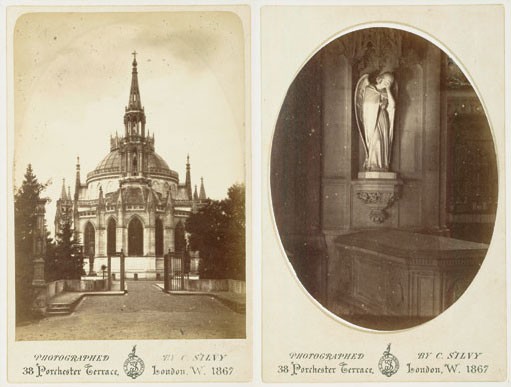Avery Architectural & Fine Arts Library Acquires Publication by 19th Century Photographer Camille Silvy
NEW YORK, August 1, 2008 The Avery Architectural & Fine Arts Library has recently acquired one of the earliest publications to use artificial, magnesium lighting in the photography of a building’s interior: Camille Silvy, Album de la Chapelle Royale Saint Louis, à Dreux, Eure et Loir. (London: Rolandi, 1867). This extraordinary survival consists of a letterpress pamphlet and ten albumen-print cabinet cards (a frontispiece, three views of the chapel exterior, and six of monuments inside), as well as the original mailer, addressed to a printer and photographer in Silvy’s hometown of Nogent-le-Rotrou, France.

The royal mausoleum at Dreux is included in the definitive survey Neoclassical and 19th Century Architecture (1980), coauthored by Columbia University Professor Emeritus Robin Middleton and David Watkin. They describe it as a “fanciful Gothic cloche,” one of King Louis-Philippe’s “handful of maverick commissions” reviving medieval style. Executed in 1842 according to designs by Pierre-Bernard Lefranc, the Gothic structure encased a Doric temple form built between 1816 and 1822 by Charles-Philippe Cramail for the Duchess of Orleans.
Upon viewing the Silvy publication recently, Prof. Middleton commented: “It was altogether unknown to me. And it is really quite interesting. The photographs give a sense of what the original building was like that you simply don’t get from later publications.”
Silvy’s experiments with artificial lighting date back to at least 1865, when he presented trial prints of the six interior subjects included in Avery’s 1867 publication to the Société Française de Photographie. He reported to the group on the inherent difficulty of photographing the vaults, due to the tombs’ distance from the windows and the intense color of the stained glass. The illuminating power of the magnesium filaments that Silvy employed is well illustrated by “The Angel of Sorrow,” who seems as much to shield himself from the light as hide his face in sadness.
The Silvy Album de la Chapelle Royale Saint Louis, which is available to researchers, by appointment, in Avery’s Classics Collection, is a particularly fitting acquisition for the Library. In 1866, its cofounder Samuel Putnam Avery published what is one of the first American architectural books illustrated with original photographs. And in a very real sense, thousands of the photomechanically illustrated books on Avery’s shelves are descendants of Silvy’s Album, their images of interiors and works of art having been captured with the assistance of artificial lighting.
Silvy’s artistic significance is recognized in the publication: Mark Haworth-Booth, Camille Silvy: River Scene, France (Malibu, 1992). A major Silvy exhibition is scheduled for 2010 at the Jeu de Paume, Paris.
Columbia University Libraries/Information Services is one of the top five academic research library systems in North America. The collections include over 10 million volumes, over 100,000 journals and serials, as well as extensive electronic resources, manuscripts, rare books, microforms, maps, graphic and audio-visual materials. The services and collections are organized into 25 libraries and various academic technology centers. The Libraries employs more than 550 professional and support staff. The website of the Libraries at www.columbia.edu/cu/lweb is the gateway to its services and resources.
The Avery Architectural & Fine Arts Library is one of the most comprehensive collections relating to architecture and the fine arts in the world. Avery collects a full range of primary and secondary sources for the advanced study of architecture, historic preservation, art history, decorative arts, city planning, real estate, and archeology. The Library contains more than 400,000 volumes, including 35,000 rare books, and receives approximately 1,000 periodicals. Avery’s Drawings and Archives collection includes one million architectural drawings and records. The Library is home to the Avery Index to Architectural Periodicals, an operating program of the Getty Research Institute, which is the only comprehensive American guide to the current literature of architecture and design.